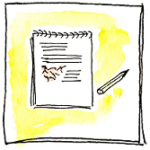Taking notes, tracking the sources of notes and keeping this information well-organized between school and home can pose many challenges.
 There are many different note-taking strategies/systems and print/digital tools to accommodate different learning styles and learning needs. Moreover, the choice of strategies/systems and tools will vary depending upon the context and scope of your research.
There are many different note-taking strategies/systems and print/digital tools to accommodate different learning styles and learning needs. Moreover, the choice of strategies/systems and tools will vary depending upon the context and scope of your research.
Your teacher-librarian and teacher will work together to find the choices that work for individual learners in specific learning contexts. However, the suggestions listed below are tried-and-tested starting points.
Regardless of the system, the “R5” Process is a process you can follow to help you decrease any chance of plagiarism, increase your comprehension of what you’re reading and researching, and meet all criteria of “S.M.A.R.T.” Notes.
| Note Making System | Purpose | Templates & Tools |
| Cornell Notes Method | - for taking notes from a lecture, interview, audio or video recording | Note Making Template |
| Mindmapping Method | - for brainstorming notes to activate prior knowledge or build knowledge with a group | |
| Outlining Method | - for organizing written text in a structured, logical way from a chapter or article. Best for Humanities and Social Sciences courses. | |
| Inverse Pyramid Method | - for organizing research notes from multiple sources |

